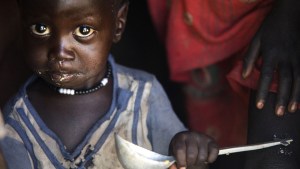Lenten Campaign 2025
This content is free of charge, as are all our articles.
Support us with a donation that is tax-deductible and enable us to continue to reach millions of readers.
By the time a famine is declared, it’s too late, said the American director of the World Food Program.
“Many people will have already starved to death,” said Cindy McCain, WFP Executive Director. “We must act now to stop these hotspots from igniting a firestorm of hunger.”
That’s why the United Nations’ Food and Agriculture Organization (FAO) and the WFP are warning in a new “Hunger Hotspots” report that the food crisis in 18 regions will get worse in the coming months.
The report focuses on 17 countries and one regional cluster of four countries (drought-affected Malawi, Mozambique, Zambia, and Zimbabwe) where acute hunger is at a high risk of worsening from June to October 2024.
“Organized violence and conflict remain the main drivers of acute hunger, with key trends indicating that levels of conflict and violence against civilians will continue to increase,” Vatican News said.
The report adds that “extreme weather conditions such as tropical storms, floods, and droughts remain critical factors in some regions.”
Getting more proactive
FAO Director-General Qu Dongyu in a press release announcing the report said, “We need to spearhead the shift from responding to crises after they occur to more proactive anticipatory approaches. Prevention and resilience building to help vulnerable communities cope with upcoming shocks. Acting ahead of crises can save lives.”
According to the report, Mali, Palestine, South Sudan, and Sudan remain at the highest alert level and require the most urgent attention. Haiti was added to the list due to escalating episodes of violence and threats to food security. Conflict is the primary driver of hunger in all these areas.
“Chad, the Democratic Republic of Congo, Myanmar, Syria, and Yemen are considered hotspots of very high concern, with a large number of people facing critical acute food insecurity, expected to further intensify life-threatening conditions in the coming months,” said Vatican News.
Since the previous edition of the Hunger Hotspots report, the Central African Republic, Lebanon, Mozambique, Myanmar, Nigeria, Sierra Leone, and Zambia have joined Burkina Faso, Ethiopia, Malawi, Somalia, and Zimbabwe in the list of danger zones, where acute food insecurity is likely to deteriorate further in the coming months.
Some of the most startling language in the report concerns the Gaza Strip, where the Israeli military has been waging a war to destroy Hamas, the militant organization responsible for a devastating attack last October.
“In mid-March 2024, famine was projected to occur by the end of May in the two northern governorates of the Gaza Strip, unless hostilities ended, full access was granted to humanitarian agencies, and essential services were restored,” said the press release. “Over one million people – half the population of Gaza – are expected to face death and starvation by mid-July. The report also warns of broader regional ramifications of the crisis, which risk exacerbating the already high food security needs in Lebanon and the Syrian Arab Republic.”
The picture coming out of Sudan is just as worrying, where the WFP-FAO says that conflict and displacement “continue at an alarming pace and magnitude.”
Time is running out to save lives and the lean season looms – the report warns. The outlook for food production is bleak, and there is a rapidly shrinking window to support farmers before the main planting season ends and the rains begin, limiting access to the hardest-hit communities. 18 million people are acutely food insecure, including 3.6 million children acutely malnourished, and famine is rapidly closing in on millions of people in Darfur, Kordofan, Al Jazirah and Khartoum. … The crisis – now in its second year – is home to the largest number of internally displaced people in the world at nearly 10 million. A further two million people have fled across borders, deepening the burden on neighboring countries hosting a steadily growing number of refugees and returnees – especially in South Sudan and Chad, where existing hunger crises are deepening by the spillover from the deadly conflict in the Sudan.



